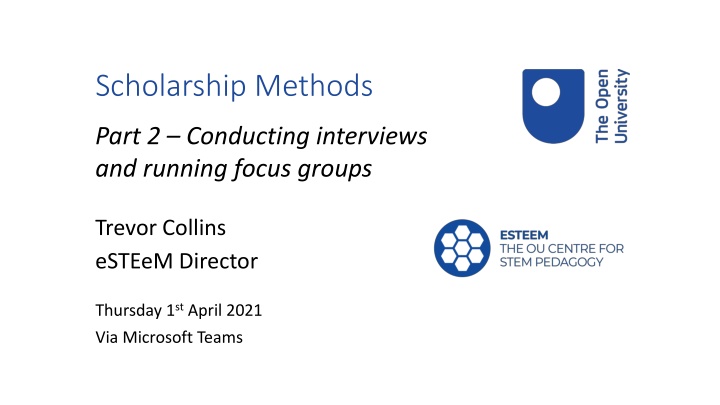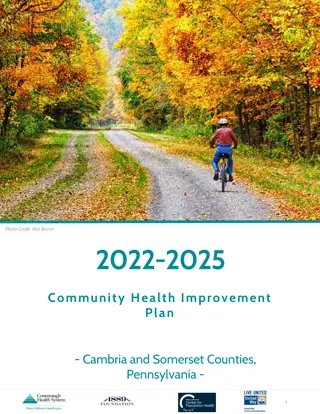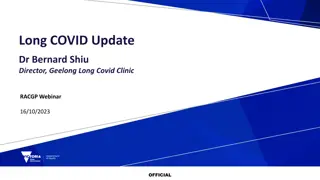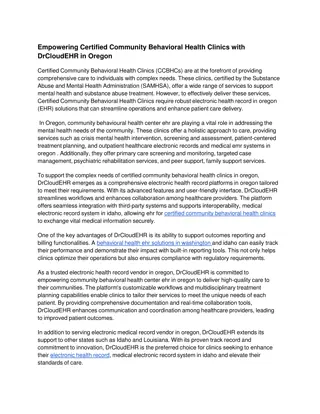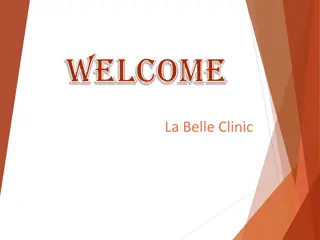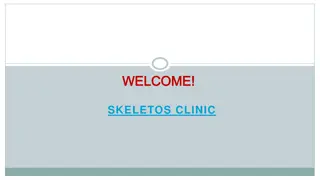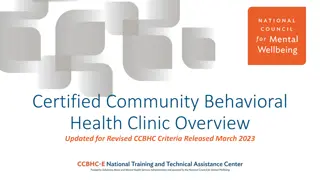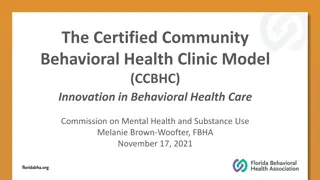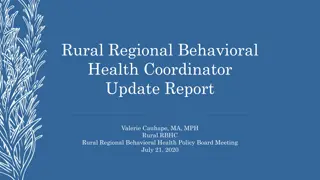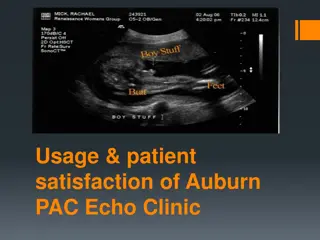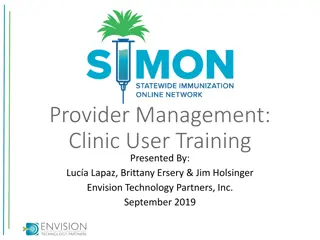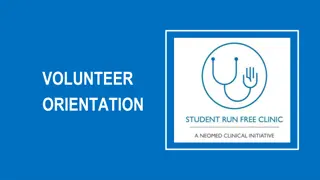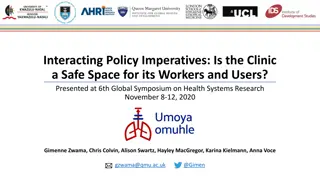Certified Community Behavioral Health Clinic Improvement Program Overview
Transform and enhance Certified Community Behavioral Health Clinics to provide comprehensive mental health and substance use disorder treatment. The program aims to improve access, quality, and coordination of care, emphasizing individualized services and community involvement. Providers are expected to meet updated certification criteria by 2024.
Download Presentation

Please find below an Image/Link to download the presentation.
The content on the website is provided AS IS for your information and personal use only. It may not be sold, licensed, or shared on other websites without obtaining consent from the author.If you encounter any issues during the download, it is possible that the publisher has removed the file from their server.
You are allowed to download the files provided on this website for personal or commercial use, subject to the condition that they are used lawfully. All files are the property of their respective owners.
The content on the website is provided AS IS for your information and personal use only. It may not be sold, licensed, or shared on other websites without obtaining consent from the author.
E N D
Presentation Transcript
Scholarship Methods Part 2 Conducting interviews and running focus groups Trevor Collins eSTEeM Director Thursday 1st April 2021 Via Microsoft Teams
Overview: Interviews and focus groups Context: Scholarship of Teaching and Learning Background: Research approaches Interviews and focus groups Interview types Planning details and data Designing questions Focus group preparation Recruitment and logistics Moderators roles: beginning, during and ending Thursday, 1st April 2021 eSTEeM - Scholarship Methods 2 - Interviews and Focus Groups 2
Scholarship of Teaching and Learning Scholarship refers to a set of activities which lead to evidence- informed innovation that will enhance teaching and learning for the benefit of students. Scholarship of Teaching and Learning (SoTL) is important in three respects: For students allowing us to systematically evaluate our teaching to improve the quality of student learning. For academic disciplines and institutions ensuring that we base innovation and future development on robust evaluation enabling our teaching and learning to be recognised externally for its excellence and impact. For practitioners allowing staff to develop their professional practice in the field of teaching and learning. Thursday, 1st April 2021 eSTEeM - Scholarship Methods 2 - Interviews and Focus Groups 3
Focusing a study Your choice of methods are determined by your Research questions Preferences and skills Philosophical worldview (paradigms) of research Research Problem Statement Identify a particular issue in need of investigation Research Purpose Statement Advance the major objective for beginning the study Research Questions Specify the guiding query for narrowing the study Figure taken from (Creswell and Poth, 2018) Thursday, 1st April 2021 eSTEeM - Scholarship Methods 2 - Interviews and Focus Groups 4
Philosophical worldviews of research Postpositivism: Causes (probably) determine effects or outcomes Constructivism: Individuals develop subjective meaning of their experiences meanings are varied and multiple (complexity of views) Transformative: Research intertwined with politics and political change Pragmatism: Concerned with applications and solutions to problems Postpositivism Determination Reductionism Empirical observation and measurement Theory verification Constructivism Understanding Multiple participant meanings Social and historical construction Theory generation Transformative Political Power and justice oriented Collaborative Change-oriented Pragmatism Consequence of actions Problem-centred Pluralistic Real-world practice oriented Thursday, 1st April 2021 eSTEeM - Scholarship Methods 2 - Interviews and Focus Groups 5
Research approaches Quantitative research: An approach for testing objective theories by examining the relationships between variables. building in protections against bias, controlling for alternative or counterfactual explanations, and being able to generalize and replicate the findings. Qualitative research: An approach for exploring and understanding the meaning individuals and groups ascribe to a social or human problem. focus on individual meaning and the importance of reporting the complexity of the situation. Mixed methods research: An approach to inquiry involving collecting both quantitative and qualitative data, integrating the two forms of data the integration of qualitative and quantitative data yields additional insight beyond the information provided by either the quantitative or qualitative data alone. Quotations taken from (Creswell and Creswell, 2018) Thursday, 1st April 2021 eSTEeM - Scholarship Methods 2 - Interviews and Focus Groups 6
Research designs A continuum of research approaches from quantitative (numbers) to qualitative (words) with mixed methods (numbers and words) combining the two Quantitative Experimental designs Nonexperimental designs, such as surveys Longitudinal designs Qualitative Narrative research (humanities) Phenomenology (philosophy and psychology) Grounded theory (sociology) Ethnographies (anthropology and sociology) Case study (many disciplines) Mixed methods Convergent Explanatory sequential Exploratory sequential Complex designs with embedded core designs Thursday, 1st April 2021 eSTEeM - Scholarship Methods 2 - Interviews and Focus Groups 7
Research methods The specific forms of data collection, analysis and interpretation Quantitative methods Qualitative methods Mixed methods Pre-determined Emerging methods Both predetermined and emerging methods Instrument based questions Open-ended questions Both open- and closed-ended questions Performance data, attitude data, observational data, and census data Interview data, observation data, document data, and audio-visual data Multiple forms of data drawing on all possibilities Statistical analysis Text and image analysis Statistical and text analysis Statistical interpretation Themes, patterns interpretation Across databases interpretation Thursday, 1st April 2021 eSTEeM - Scholarship Methods 2 - Interviews and Focus Groups 8
Example research scenarios Quantitative approach Postpositivist worldview, experimental design, and pre-test and post-test measures of attitudes (tests a theory by specifying a hypothesis and collecting data to support or refute it) Qualitative approach Constructivist worldview, ethnographic design, and observation of behaviour (establish the meaning of a phenomenon from the views of the participants) Qualitative approach Transformative worldview, narrative design, and open-ended interviewing (examine an issue related to oppression of individuals individuals interviewed to determine their experiences) Mixed methods approach Pragmatic worldview, collection of quantitative and qualitative data sequentially (survey followed by open-ended interviews) Thursday, 1st April 2021 eSTEeM - Scholarship Methods 2 - Interviews and Focus Groups 9
Interviews and focus groups Interviews Allow for in-depth discussion with an individual Easy to schedule More suitable for sensitive topics More time consuming than focus groups Reactive effects (influence of the interviewer) Focus groups Allows for group discussion, interaction Need to coordinate and manage multiple participants More efficient than interviews (collect data from multiple people) Subject to group dynamics (group effect) Less anonymous (sensitive topics) Thursday, 1st April 2021 eSTEeM - Scholarship Methods 2 - Interviews and Focus Groups 10
Interview types Face-to-face Same time and place Pick up on non-verbal cues Phone, Skype, Teams, IM text-chat Same time, different place Wider reach in terms of recruiting participants Email Different time, different place Allows participants to consider their answers before responding Thursday, 1st April 2021 eSTEeM - Scholarship Methods 2 - Interviews and Focus Groups 11
Details to consider Length of session Interviews: 30 mins to 1 hour Focus groups: 1 to 2 hours Number of participants Concept of saturation : where additional numbers don t provide any additional insights Rough estimate (for homogenous groups) Interviews: 10 to 15 participants Focus groups (f-t-f): 6 to 10 participants Focus groups (online): 4 to 8 participants Participants will drop out at the last minute Thursday, 1st April 2021 eSTEeM - Scholarship Methods 2 - Interviews and Focus Groups 12
Data to collect Note taking Can be difficult to write notes and listen Useful to have an assigned note-taker in a focus group Recordings Audio recorders Video cameras In-built function (Teams or Adobe Connect) Will require transcription (10 mins recording takes 30 mins to transcribe) Chat logs and emails Thursday, 1st April 2021 eSTEeM - Scholarship Methods 2 - Interviews and Focus Groups 13
Designing questions Structured, semi-structured and unstructured interviews General advice Questions should relate to the project s aim Keep them simple and short Avoid the use of jargon (e.g., unfamiliar acronyms, specialist terminology) Don t have too many questions (keep in mind how long the session will be) Pilot and refine your questions Things to avoid Multiple questions (e.g., How did you allocate the students to role play partners, prepare them for the exercise and ensure all students understood what was required of them? ) Leading questions (e.g., Please explain the value of the role play exercise in helping the students to develop their patient care skills Yes or no questions e.g., Did you talk to your students about the exercise? Thursday, 1st April 2021 eSTEeM - Scholarship Methods 2 - Interviews and Focus Groups 14
Types of questions Pre-determined questions Identify potential questions in advance Open-ended questions What did you think of the ? How did you feel about the ? What do you like best about ? Think back questions Take people back to an experience and not forward to the future Activity Consider a scholarship project you are working on (or plan to work on) Create a few main questions or topics that you could ask about Try creating some pre-determined, open-ended and think back questions (including prompts and follow-up questions) What would you expect them to say? What would these answers tell you? Thursday, 1st April 2021 eSTEeM - Scholarship Methods 2 - Interviews and Focus Groups 15
Focus groups Before the focus group Preparation, recruitment, logistics During the focus group Moderator(s), beginning, during, ending After the focus group Transcription, analysis, reporting Thursday, 1st April 2021 eSTEeM - Scholarship Methods 2 - Interviews and Focus Groups 16
Focus group preparation Before the session Online versus face-to-face How many sessions will be conducted? How many participants should be recruited? Logistics: arranging the location, room, equipment, drinks/snacks? How to prepare yourself skillfully as a moderator? What will you ask? Prepare the questions How many participants? Preferred number of carefully selected similar types of focus group participants is 6 to 8 (Krueger, 2002) Max. 10 people is suggested per session (Morgan, 1996; Krueger, 2002) If online have less: 4 to 6 How many focus groups? Preferably more than one Rule of thumb is 4 to 6 focus groups (Morgan, 1996) Thursday, 1st April 2021 eSTEeM - Scholarship Methods 2 - Interviews and Focus Groups 17
Recruiting participants Heterogeneous groups (different) Heterogeneous groups may be ideal if you don t plan to have several focus groups and use it in combination with other methods Heterogeneous groups may spark more ideas, and you would collect different points of views in one go Homogenous groups (same) Participants could be as homogeneous as possible by age, sex, marital status, socioeconomic status, location, etc. Homogeneous groups tend to be more willing to share their feelings (e.g., women only groups) Could have multiple focus groups with different sets of homogenous groups (ideal if focus groups is the only method) Thursday, 1st April 2021 eSTEeM - Scholarship Methods 2 - Interviews and Focus Groups 18
Logistics Location of the focus group session should be comfortable Face-to-face: Need to arrange a large enough room with participants preferably seated in a circle to encourage interaction Online (e.g. Skype, Teams or Adobe Connect) Wider recruitment reach (no need for traveling) Script/questions, prompts/artefacts, equipment for recording Drinks, snacks and comfort breaks Thursday, 1st April 2021 eSTEeM - Scholarship Methods 2 - Interviews and Focus Groups 19
Moderator(s) Lead and assistant moderator(s) sessions are moderated by the researcher who runs the discussions, and an assistant moderator who will not participate in the discussion but arrange logistics such as helping with the equipment, refreshments, arranging the room, recording the session, etc. (Krueger, 2002). Most importantly the assistant moderator can take notes Thursday, 1st April 2021 eSTEeM - Scholarship Methods 2 - Interviews and Focus Groups 20
Beginning Welcome Introduce yourselves Overview Topic is Will be used to inform You were selected because Ground rules No wrong answers, just different views No need to agree with others, etc. Tape/video recording Opening question Thursday, 1st April 2021 eSTEeM - Scholarship Methods 2 - Interviews and Focus Groups 21
During the dos and don'ts Do listen for inconsistent, vague and cryptic comments and probe for understanding Would you explain further? Would you give an example? I don't understand. Control your reactions to participants and avoid head nodding, affirmative hmms, short verbal responses: that's good , excellent Don t lead the participants or impose your thoughts (and lose the participants who might not agree with you) Ensure everyone has chance to participate manage dominant talkers and encourage shy participants Thursday, 1st April 2021 eSTEeM - Scholarship Methods 2 - Interviews and Focus Groups 22
Ending Consider asking each participant a final preference question Offer a summary and seek confirmation Three Step Conclusion: Summarise with confirmation Review purpose and ask if anything has been missed Thanks and dismissal Follow-up activity Richard Krueger s video tutorial https://youtu.be/xjHZsEcSqwo Thursday, 1st April 2021 eSTEeM - Scholarship Methods 2 - Interviews and Focus Groups 23
Overview: Interviews and focus groups Context: Scholarship of Teaching and Learning Background: Research approaches Interviews and focus groups Interview types Planning details and data Designing questions Focus group preparation Recruitment and logistics Moderators roles: beginning, during and ending Thursday, 1st April 2021 eSTEeM - Scholarship Methods 2 - Interviews and Focus Groups 24
Bibliography Creswell, J.W. and Creswell, J.D. (2018). Research Design: Qualitative, Quantitative, and Mixed Methods Approaches. 5th Edition. Sage Publishing ISBN: 978-1-5063-8676-8 Creswell, J.W. and Poth, C.N. (2018). Qualitative Inquiry and Research Design (International Student Edition). 4th Edition (14 May 2017). Sage Publishing ISBN: 978-1-5063-6117-8 Hamilton, R. J., & Bowers, B. J. (2006). Internet Recruitment and E-Mail Interviews in Qualitative Studies. Qualitative Health Research, 16(6), 821-835. https://doi.org/10.1177/1049732306287599 Holliman, R. (2005). Reception analyses of science news: evaluating focus groups as a method. Sociologia e Ricerca Sociale, 26(76-77), 254-264. http://oro.open.ac.uk/604 Krueger, R.A. and Casey, M.A. (2015). Focus Group: A Practical Guide for Applied Research. 5th Edition. Sage Publishing ISBN: 978-1-4833-6524-4 https://richardakrueger.com/focus-group- interviewing Morgan, D.L. (1996). Focus Groups. Annual Review of Sociology, 22(1), 129-152. https://doi.org/10.1146/annurev.soc.22.1.129 Thursday, 1st April 2021 eSTEeM - Scholarship Methods 2 - Interviews and Focus Groups 25
